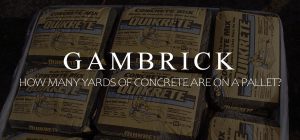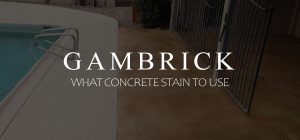
Is Concrete Porous?
Concrete is a very porous material. It starts off as a dry mixture made of cement, sand and gravel. Once clean water is added, the cement chemically reacts and forms a paste that binds the sand and aggregate together. As wet concrete dries, hardens and cures, water evaporates out. This leaves behind a network of very small tunnels where the water used to be. On average, 10%-15% of a concrete slab has these tiny pores. You can’t see them with your eye, but they’re why concrete absorbs water like a sponge.
I’ve been a mason and home builder for over 25 years and can tell you firsthand that all concrete is porous. No matter how you alter the mixture, water must evaporate out during curing which leaves behind pores.
Concrete is a porous material, though the extent of those pores depends on the type of concrete. It’s impossible to create concrete that is not porous due to the materials it’s made of and evaporation, but the size of the pores can be controlled a bit.
Concrete pores are very small, but still much larger than water or gas. Water vapor and soil gases, including radon gas, can flow right through a concrete slab. It’s very easy for thin slabs of concrete to draw water from the soil and into your basement. Water and gasses are attracted to the difference in pressure between a basement and the soil. Gases like radon flow even easier than water because of how small they are. This is where a good plastic barrier can help.
Concrete can be poured in a light rain, but the extra water makes the slab even more porous when it evaporates out. keep this in mind when you pour concrete in bad weather.
Is Concrete Watertight?
No, concrete is not water tight. However, when it’s poured extremely thick, such as with a large footing, it can appear to be.
It’s very unlikely that pores will work they’re way entirely through a thick slab. It’s easy for water to pass right through a 4″ – 6″ slab because pores can run from end to end. But when a slab is 2 foot thick it’s very unlikely. This can make a concrete footing or wall appear water tight. But it’s not. The water is actually just absorbing on the surface because the tunnels and pores get broken as the concrete gets thicker. If a pore got lucky and ran through the 2 foot of concrete without being broken then so will the water.
Did you know that concrete can actually float? When concrete is poured into the correct shape it can actually float really well. This is due to surface area and displacement of water and not because the concrete is water tight. In the past, boats, walkways and barges have actually been made out of concrete. So why don’t they absorb lots of water and sink?
- Because it’s poured thick enough that water doesn’t easily pass through it.
- On average concrete is only 10%-15% porous so that leaves lots of solid pass to float.
- A sealant can be used to keep water out.
Dams are made out of concrete and they hold back tons of water. Are they water tight? No,damns leak in lots of places and the concrete absorbs water just like all concrete does. But it can be poured over 10 foot thick in some areas which makes it very unlikely that water would penetrate.
So no,concrete is not water tight.
Mixing Concrete
Concrete is a material made up of various components. These ingredients are mixed together in specific ratios that alter the concrete’s properties. If you want a weaker but easier to work with concrete then add more cement and sand but less stone. However, if you want more strength add more stone but less sand and cement.
The properties of the ingredients changes it’s makeup too. Large stones or small. Course sand or very fine.
The way you alter concrete ingredients not only changes it’s strength and work ability but also it’s pores. The stronger concrete gets the more porous it becomes because larger and courser materials allow more space for voids and pores.
- Sand. When you add sand it gives concrete some grit which helps hold it together.
- Stone Aggregate. This is where concrete’s great strength comes from. The more stone you add the stronger it gets.
- Cement. This is the binding agent. Without cement, concrete wouldn’t be possible.
There are lots of concrete mixes available on the market in prepackaged forms like Quikrete. Each of them has a different ratio of aggregate, cement and sand material which alters the concrete properties.
Water is added to dry concrete mixture which creates a substance like very thick oatmeal. It can then be poured and worked to create different shaped objects and structures. Usually this involves pouring it into a form.
Concrete is is one of the most widely used materials in the world to build roads, homes, patios, sidewalks, bridges and buildings. And all of that concrete is very porous and absorbs water.
Drying Forms Pores
After the concrete is mixed and poured, it starts to dry and harden. About 50% of the water used to mix the concrete evaporates out as the concrete hardens. This leaves behind a tunnel system and lots of tiny pores. Every place a water molecule evaporates out of the concrete leaves behind a pore. Those tunnels and pores dry with the concrete and remain in place long after the job is done.
Concrete actually gets stronger the longer it takes to dry. The long term drying and strengthening of concrete is called curing. When concrete is allowed to fully cure, meaning it is kept slightly wet to slow the process down, it gets extremely string. The entire process can take around 28 days to fully complete. Water continues to evaporate out of the concrete as it hardens. However, not tunnels and pores do not form for the entire 28 days. Pores are generally only formed in the first few hours. Once concrete is hard enough to walk on the pores are finished forming.
Concrete is a very dense material that absorbs and hold heat really well. Like most materials it can expand and contract slightly. Over time, this expansion and contraction can lead to small cracks. Sometimes tiny hairline cracks can even form as the concrete dries. This is why a concrete surface should be kept damp for the first day or so as it evaporates water.
These tiny cracks also absorb water but are not considered pores.
Concrete Is Very Porous
Concrete is made up of different ingredients mixed together to form a new material. Each ingredient has a different size and takes up space to varying degrees. This also adds to concrete porous structure. Cement binds the ingredients together. It’s the paste that works it’s way into all the little nooks and crannies between stones. But it can’t fill them all. Inevitably there will be some small voids inside a slab where water can be absorbed and trapped. If pores and tunnels lead to these voids they’ll fill up with water.
However, this doesn’t mean there are going to be holes in objects made of concrete. Generally, you actually can’t see the pores in the concrete. These voids and pores are very tiny and are hard to see by eye. But they’re big enough for water and gas to pass through.
The pores created by water are known as capillary pores. They can be reduced by jigging the concrete. As concrete is poured, masons will use tools to jog or shake the concrete. This causes air to evaporate and small voids to be filled with cement. If you don’t properly jig concrete you’ll see lots of bubbles and voids running right through the slab. However, when concrete is properly jigged, it becomes much denser and less porous. This is easy for builders to test by cutting slabs of concrete in half to see what’s inside.
Capillary Pores
Excessive amounts of capillary pores can decrease concrete’s strength. Like we’ve said, all concrete has pores. There’s no way to make concrete that doesn’t evaporate water. But you want to minimize them as much as possible. This is done by jigging the concrete.
Here’s an experiment, fill a glass container with rocks. You’ll notice how many unfilled spaces there are. No matter what you do there will still be voids. These voids are where cement and sand come in. They fit in between all the voids and bind stone together. By jigging the concrete,you help cement work it’s way into all the voids which makes concrete stronger and less porous.
Masons tools called jigs are used to shake concrete. This is done by hand in smaller applications like concrete countertops. If you don’t properly shake the countertops when the concrete’s wet you’ll get lots of bubbles and voids when the forms are removed. This leaves a very ugly edge and creates a more porous countertop. Pores in a countertop are bad because they not only hold water but also germs. You can prevent a lot of this my shaking the concrete to help it settle and release air.
Cement, which binds concrete together, contains platelets of calcium. Since calcium is soluble in water, pores can get gradually larger and larger over time when exposed to water. A perfectly dry basement can start smelling musty, feeling humid, and eventually can start seeping water as pores get larger.Once the process starts there’s not much you can do about it. The best prevention is done at install. Make sure to jig as many voids out of the concrete as possible and use a good quality vapor barrier under the slab.
Remember, you’ll never get out all the pores, but you can limit them.
How Do You Make Concrete Less Porous?
There are a few steps you can take to make concrete less porous.
The best way to make concrete less porous is to alter the mix. High strength concrete has a lower water to cement ratio which helps cut down on the pores. This is also referred to as high-performance concrete or HPC. Remember, most of the pores are caused by water evaporation so less water in the mix means less evaporation. Water also weakens the concrete. So if you want concrete to be as strong as possible you need to carefully control it’s water content.
Another way to reduce pores is by jigging, vibrating or shaking the concrete. By moving it around you help cement fill in all the small voids between stones. You also help air escape from the concrete which prevents internal bubbles. This comes in handy when making cast concrete products like countertops that need a smooth edge. Jigging creates a denser concrete which is both stronger and less absorbent.
Using smaller, rounder stones is another way to cut down on voids. Rounded edges makes it easier for cement to fill in all the small gaps. Small stones also makes the concrete easier to work with. The downside is that your concrete will be weaker.
How To Make Concrete Water Tight
If you want concrete that’s water tight then you need to properly seal it. Sealants are a liquid you put on with either a sprayer, brush or roller. It fills all the tiny pores, cracks and gaps and then dries in place. When all the pores are filled with sealant, water can’t penetrate.
Sealing concrete is great way to protect it against not only water but also damage from the freeze thaw cycle. If you live in cold climates, water can soak into concrete when its warmer and then freeze. Over time that freezing and thawing can crack the concrete.
Sealants aren’t a perfect product though. They can’t fill anything but very small cracks and gaps so make sure to repair or fill those with cement or caulk before you seal.
Sealants also don’t last very long. Most have to be replaced every 4-6 months. This will vary based on weather conditions and the sealant you use.
Then there are thicker sealants like tar. This typically done to waterproof below grade concrete. When we build a foundation we apply a layer of tar anywhere dirt will touch. The tar seals the pores and prevents water from absorbing into the concrete. And it lasts a very long time which is crucial for below grade applications.
Another way to make concrete waterproof is to cover it with a rain screen layer. This can be made of foam insulation, vapor barriers, a space for air flow, stone, brick, stucco, siding, etc. When water is prevented from touching the concrete it remains dry.
Conclusion
Concrete is a fantastic building material that’s used in almost every kind of construction because of its great strength and versatility. However, it’s not perfect and has some flaws which includes being very porous. If you’re using concrete in your next project, you should take into consideration how porous concrete is and take steps to prevent it.
I highly recommend sealing your concrete with tar for all below grade applications to keep water out. Also seal your exposed above grade flat concrete with a good quality sealant as needed. This works great for things like patios and walkways. I also like to include a vapor barrier under by interior slabs to keep water from penetrating up and through the slab.
It’s also a good idea to use as little water as possible when mixing concrete. Water weakens concrete and creates more pores so use just as much as you need. It makes the concrete harder to work with but it’s worth the extra effort. And don’t forget to jig the concrete before it fully hardens.
While you can’t eliminate all the pores in your concrete, there are some things you can do to deal with them.
Summary: Is Concrete Porous?
Is siding waterproof? Yes and no. The siding itself can be waterproof if it’s made of a composite material. For example, vinyl siding is waterproof because it’s primarily made from plastic. But wood and fiber cement siding are not. They both absorb water and need a sealant like paint to help them resist moisture. The question should really be, does siding make your home waterproof? And the answer is no. Even vinyl siding is not considered waterproof when it’s installed on a house. In fact, no siding is 100% waterproof. It’s all considered water resistant. Even a tiny gap is enough to let moisture in which can eventually damage the house. This is why other waterproofing methods are used in addition to siding. Things like caulk, flashing, sealants, tape, trim and house wrap.
Residential and commercial properties are both prone to water damage due to penetration through the siding. Every house and building has some sort of siding. But water damage is still the number one cause of damage we see. Mold, mildew and rot are all common issues caused by water penetrating the siding.
The question is: what keeps water out? Multiple layers of protection is the way to go. A good quality house wrap under the siding helps protect against water damage by stopping moisture that gets behind the siding. You should also use caulk to fill small gaps, tape around windows, use flashing and trim. Siding serves as the initial watershed, protecting the homes from damage, but it can’t do the job alone.
Even though siding is not 100% waterproof, by using multiple methods and materials to prevent water you can stop moisture from penetrating and damaging the home.
If you have any questions or comments about concrete E-mail any time.

John Mazzuca | About | More Posts |
Custom Home Builder
John Mazzuca is a custom home designer and builder at Gambrick with over 25 years experience in the construction industry. John has designed, built and/or remodeled hundreds of homes, small buildings, and commercial projects. He writes about business, real estate, home building, and household electronics. His work has been featured in Fox Business, Better Homes & Garden, House Beautiful, and more.




















